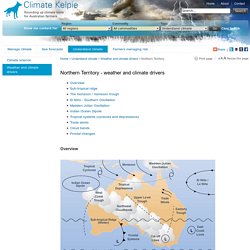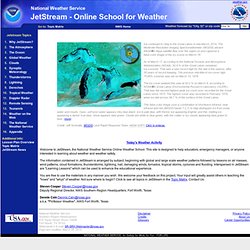

Northern Territory - weather and climate drivers. Overview Figure 1.

The major weather and climate drivers across Australia (Bureau of Meteorology 2010) The climate of the Northern Territory (NT) is distinctly different from that of southern Australia. The NT is so large that its climate varies greatly between its northern and southern extremities, ranging from a tropical climate in the north through to a semi-arid or desert climate in the south. The northern and, to a lesser extent, central parts of the NT experience two distinct seasons: the 'wet' (October to April)the 'dry' (May to September) The southern part of the NT experiences all four conventional seasons; summerautumnwinterspring The two main atmospheric pressure systems that drive the NT’s climate are the sub-tropical ridge and the monsoon trough. The NT’s main climatic drivers are summarised in Table 1. Table 1. Back to top These climatic drivers can modify synoptic features in the NT as summarised in Table 2. Table 2. Sub-tropical ridge The monsoon / monsoon trough Figure 2.
Figure 3. Schools - what is weather. Weather for Schools. Argo - integrated global observation strategy. JetStream - An Online School for Weather. Ice continued to cling to the Great Lakes in mid-March, 2014.

The Moderate Resolution Imaging Spectroradiometer (MODIS) aboard NASAs Aqua satellite flew over the region on and captured a false-color image of the icy scene on March 18. As of March 17, according to the National Oceanic and Atmospheric Administration (NOAA), 82.8 % of the Great Lakes remained ice-covered. That sets a new record high for this late in the season, after 35 years of record keeping. The previous mid-March ice cover high, 75.85% covered, was set on March 15, 1978. The ice cover peaked this year at 92.2 % on March 6, according to NOAAs Great Lakes Environmental Research Laboratory (GLERL). This false-color image uses a combination of shortwave infrared, near infrared and red (MODIS bands 7,2,1) to help distinguish ice from snow, water and clouds.
Credit: Jeff Schmaltz, MODIS Land Rapid Response Team, NASA GSFC Click to enlarge. Welcome to JetStream, the National Weather Service Online Weather School. Choosing a Weather Station – The Definitive Guide. Weather Stations - Monax. Weather Stations & Accessories. Get a clear indication of the weather in your location.

Weather Stations are instruments used to measure atmospheric conditions including temperature, humidity, rainfall, wind speed/direction, barometric pressure plus more, depending on the station. A home user might just have an interest in the weather and would love to know the conditions at their house. But a professional user may have to meet certain regulations or run experiments in specific locations. A basic weather station great for a home user starts with a measuring temperature and humidity along with barometric pressure. For more measurements you may like to look at a station which also measures precipitation (rainfall), wind speed and wind direction. For companies and organisations who need to measure weather parameters, our professional range of weather stations have improved accuracy and long term performance.